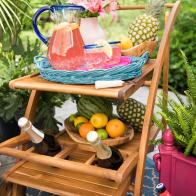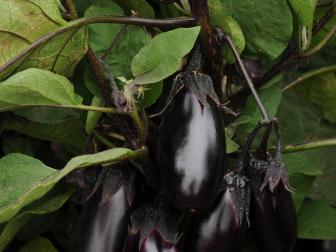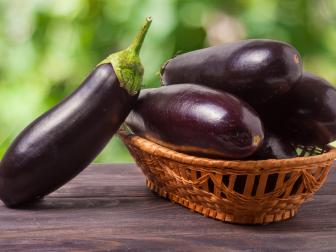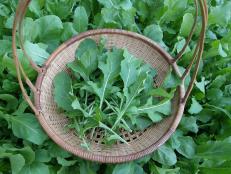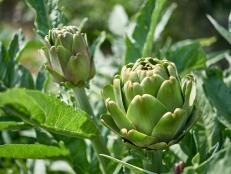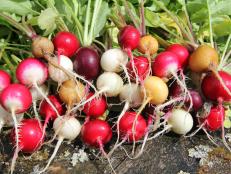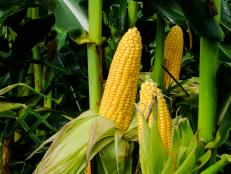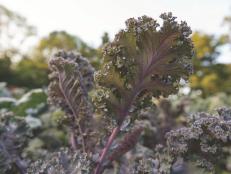Planting and Growing Eggplant
HGTV shares how to grow eggplant, including tips on planting eggplant, choosing the right variety for your garden and harvesting this delicious, heat-loving crop.
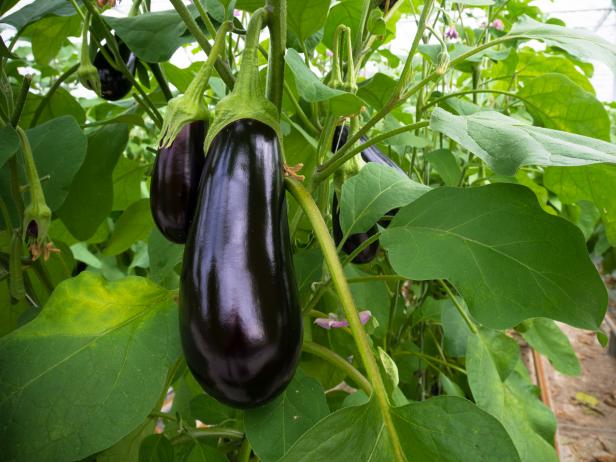
Shutterstock/Hans-Engbers
Grow eggplant in a spot that gets at least 6 hours of direct sunlight and you'll be rewarded with glossy fruit that's delicious baked, fried and even pickled.

Eggplant’s bold, silver foliage and glossy fruit make it an attractive addition to any garden bed. There are many varieties of eggplant to choose from. Fruit can appear speckled or striped and come in hues from the deepest purple to pure white. And fruit ranges in size from large and bell-shaped to small and egg-like.
Eggplant is more than just a pretty fruit, though — it’s delicious baked, sauteed, fried, pickled and more, especially when it’s freshly picked and homegrown.
Choosing Which Type of Eggplant to Grow
If you’re growing eggplant from seed, the diversity of choices can be staggering. Considering the type of fruit, size of the plant, number of days before harvest and disease resistance will help you narrow down the choices to varieties that will perform best in your garden.
Types of Eggplant
Colors range from dark purple to pale white, along with green, speckled and striped varieties. There are many shapes and colors to choose from – especially when grown from seed. Choices from the garden center can be a little more limited as retailers usually stock just a few varieties in high demand.
Classic Italian varieties are large with rounded or bell shapes and may have slightly thicker skins than other eggplant types. ‘Black Beauty’ grows large, deep purple fruit in a classic eggplant shape. ‘Paloma’ has bright white skin and a creamy texture. ‘Rosa Bianca’ has rounded, mid-size violet fruit with white streaks.
Asian eggplant varieties have thin skin and produce either smaller, rounded fruit or elongated fruit that grow up to 10 inches in length. ‘Calliope’ is an Indian variety known for its rounded, 4 inch long purple and white striped eggplants. ‘Ichiban’ Japanese eggplant grows deep purple, 10-inch-long fruit. ‘Kermit’ is a prolific Thai variety that sets a heavy crop of small, 1½-inch green and white fruit.
Plant Size
Eggplants vary in size, ranging from 18 to 48 inches in height. Gardeners with limited space should look for petite varieties like the All-American Awards winners ‘Fairy Tale,’ ‘Hansel,’ ‘Gretel’ and ‘Patio Baby.’ These small eggplants are productive in tight spaces and pots.
Days to Maturity
Northern gardeners with fewer warm summer days should look for varieties that mature quickly. Even if you plan to start seedlings indoors, short summers will cut the harvest short, too. Choose a variety that sets fruit early to improve your yield.
Disease Resistance
Eggplants are susceptible to several potentially devastating diseases. In addition to good cultural practices such as growing plants in their ideal environment, following a crop rotation and using proper sanitation, look for varieties listed as disease-resistant and choose disease-free seeds and plants.
Getting the Eggplant Growing Site Ready
Eggplant grows best in a spot that gets at least 6 hours of direct sunlight and with well-drained soil that’s amended with lots of organic matter. Get a soil test to learn how to improve the garden for a bountiful harvest and follow a crop rotation schedule to limit pest and disease issues.
Add Organic Matter
Mix a healthy dose of rich compost or well-rotted manure into the soil a few weeks before planting eggplant in the garden. The organic matter will slowly decompose into the soil, providing a steady flow of nutrients through the growing season. Organic matter will also increase the water-holding capacity of the soil, improve drainage and feed beneficial members of the soil ecosystem.
Do a Soil Test
It’s a good idea to perform a soil test to identify the amount of nutrients, pH level (or the acidity and alkalinity) and percentage of organic matter in the soil. A soil test report will provide tailored recommendations for how to improve the garden bed before planting eggplant and detail the type and precise amount of fertilizer to give your plants during the season. Follow those recommendations, as over-fertilizing can cause plants to focus more on growing leaves and stems rather than flowers and fruit. The flush of fresh growth caused by overfertilization will also make plants more attractive to pests like aphids.
Practice Crop Rotation
Eggplant and its relatives in the nightshade family (including tomatoes, tomatillos, peppers and potatoes) can be susceptible to the same health issues. Grow eggplant and other nightshades together and move them to a new area of the garden each season to prevent insect eggs and disease spores from building up in the soil and infecting new plants.
How to Plant Eggplant
When do Eggplants Grow Best?
Eggplant loves when daytime temperatures are between 77 and 95 degrees and nighttime temperatures are between 70 and 80 degrees. This heat-loving crop is usually grown in the summer in most parts of the country. Summers in the Deep South may be too warm for good eggplant production, but eggplant may be able to grow as a winter crop in those areas. If you live in the South and aren’t sure when to plant, check with your state extension service to learn the time of year eggplant grows best in your area.
Starting Eggplant Seeds Indoors
Get a head start on the growing season and give plants a better chance of surviving flea beetles by starting eggplant seeds inside. Start seeds indoors 8 to 10 weeks before your region’s average last frost date. Fill a shallow pot or planting tray with a fine-textured seedling mix. Sprinkle seeds on top of the mix and lightly cover seeds with about 1/4 inch of seedling mix or vermiculite. Place the tray on a heating mat to speed up germination and increase the number of seeds that sprout.
Once the seeds have sprouted, make sure the seedlings are getting enough light, either from a bright grow light or sunny window. Transplant seedlings to a larger pot after the second set of leaves (also called the "true leaves") open up. Gently lift the seedling, place it in the center of its new pot, carefully cover the roots with soil and then water well.
Begin to acclimate (or "harden off") seedlings to the outside world a couple of weeks before you plan to plant. Set the plants in a sunny, protected spot outdoors and bring them inside at night. If temperatures are forecast to dip below 50 degrees, keep your eggplant seedlings inside that day.
Purchasing Eggplant Transplants
If you buy eggplant plants from a garden center, look for sturdy plants with stems roughly the width of a pencil. The leaves should be healthy -- without spots or insect damage. Try to avoid buying plants that already have flowers or fruit because they may take longer to become productive in their new home.
Planting Eggplant Outdoors
Wait to plant your eggplant seedlings outside until evening temperatures are consistently above 50 degrees. Cool weather can stunt plants and delay flowering. Spacing requirements will differ between varieties, so be sure to check the plant label or seed packet to find how much room to leave between plants. A good rule of thumb is to space plants at least 2 feet apart.
Growing and Caring for Eggplant
Water Needs
Eggplants need at least an inch of water a week, either from rain or irrigation. Water deeply, allowing the water to penetrate the soil below the plant rather than run off to the side. If you are using a watering wand hose attachment or a watering can, you may need to water, then wait for the water to move into the soil, then water again to ensure the soil around the plant roots is sufficiently moist.
Take care to water the soil where the plant roots are rather than the foliage above ground. Delivering water directly to the soil without splashing the leaves and stem is a more efficient way to water and cuts down on water-borne diseases. Use a soaker hose or a drip line to deliver a slow and constant stream of water directly to the soil below the plant with no risk of splashing.
Pinch and Stake Plants
Bushy eggplants tend to be more productive than tall, gangly plants. Pinch the top bud when the plant is about 10 inches tall to promote more branching. This is also a great time to secure plants to a stake or inside a tomato cage. A little added support will prevent heavy fruits from breaking stems later in the season.
Eggplant Pollination
If pollinated, eggplant flowers usually lead to eggplant fruit. Like other nightshades, eggplant flowers are generally capable of self-pollination (that is, each eggplant flower won’t need pollen from a different flower in order to develop fruit). However, visits from buzzing bees usually increase pollination rates and improve yields. Avoid using pesticides that can harm bees and other beneficial insects, and companion plant with hooded flowers in the bean family to increase visits from pollinators.
Companion Planting for Eggplant
One of the most beautiful vegetable garden plants, eggplant can be plagued by pests like flea beetles. Try companion planting techniques to protect your eggplant crop.
Control Weeds
Weeds compete with your eggplant for water, sunshine and nutrients. They can also harbor pests and diseases that eggplant are susceptible to. Check your garden for weeds at least once a week, and pull weeds while they’re small to avoid disturbing eggplant roots. Spread a healthy layer of straw, pine straw, wood chips, shredded bark or compost mulch to suppress weed growth, conserve water and feed the soil.
Scout for Health Issues
Flea beetles, Colorado potato beetles, stink bugs, whiteflies, aphids, thrips, mites, hornworms, leaf miners, root-knot nematodes, bacterial wilt and blight pose potential health problems for eggplant. To prevent most of these issues, follow a crop rotation schedule, start with disease-free seeds and plants and experiment with companion planting. Check your plants regularly for any issues and reach out to your local extension service for help diagnosing and treating health issues.
Flea beetles are an extremely common problem on eggplant. Although flea beetles can be devastating to seedlings, mature plants will tolerate a little flea beetle damage just fine. Transplant vigorous, healthy seedlings that will be able to withstand flea beetles better than smaller plants. If you’ve struggled with flea beetles in the past, protect plants and exclude pests by covering your young eggplant with floating row covers. Row covers need to be in place right at planting to keep flea beetles out rather than trap them inside with the eggplant.
How to Harvest Eggplant
Eggplants are usually ready to harvest 100 to 120 days after planting seed or 65 to 80 days after transplanting seedlings. Harvest fruit when it is ripe and glossy. A good ripeness test is to push down on the fruit with your thumb. If this leaves an indentation, the fruit is ready to harvest.
How to Freeze Eggplant
Homegrown eggplant is delicious and then some. When you have more than you can eat, learn how to freeze eggplant for later use.
Harvest eggplant by snipping the stem above the fruit with clean and sharp pruners. Don’t try to pull eggplant fruit from the plant, as this may rip the stem or damage the plant. Eggplants are more productive when they are harvested regularly. In fact, production will slow down if fruit is left on the vine for too long. Overripe fruit will be dull and yellow and it won’t taste nearly as good.
Eggplant Recipes from Food Network
Get Food Network's best eggplant recipes — from cheese-topped eggplant Parmesan to hearty moussaka and more.

%20Taniya%20Nayak,%20Ty%20Pennington,%20Alison%20Victoria,%20and%20Brian%20and%20Sarah%20Baeumler_BOTB_HGTV%20.jpg.rend.hgtvcom.196.196.suffix/1683310636672.jpeg)


